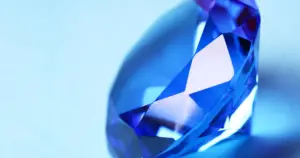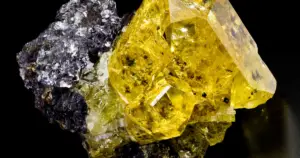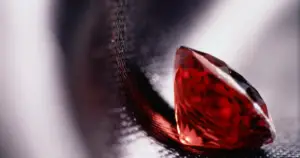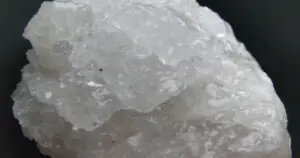Are Peridot and Moldavite the same?
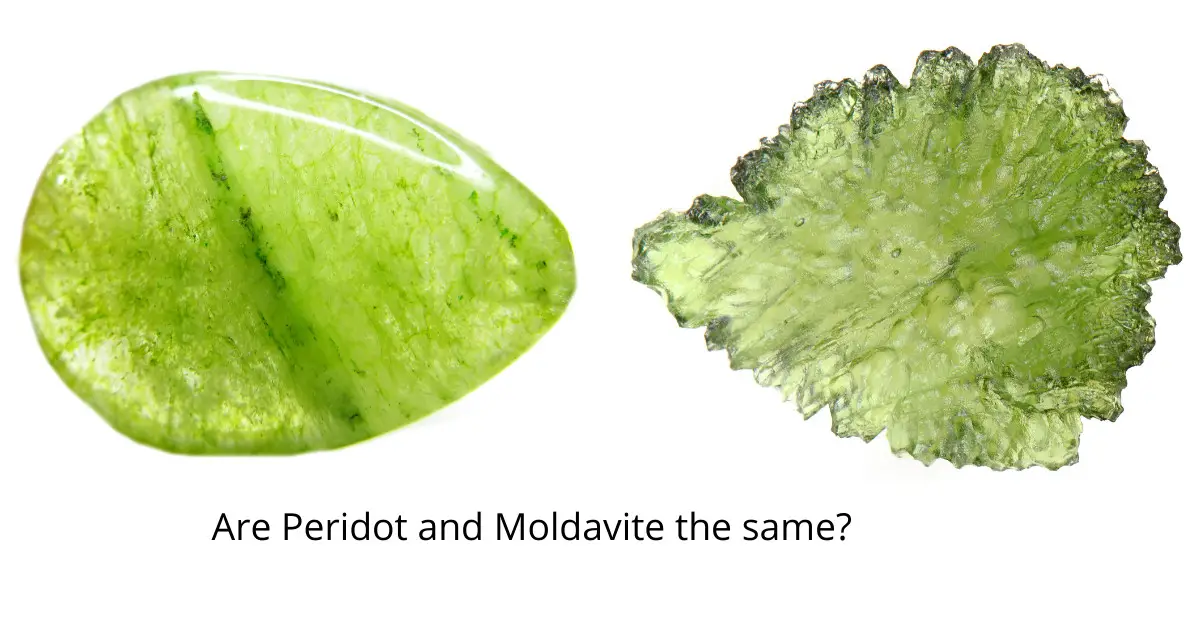
When tumbled or polished, Peridot and Moldavite are opaque gemstones with a greenish tint. The chemical makeup of the two stones differs, despite being formed at high pressure.
In this article, we will understand all about Peridot and Moldavite, the disparities and similarities between the two, and the facts.
Quartz, emeralds, and diamonds are examples of gemstones that form below the earth’s surface. Several may, however, have extraterrestrial formation.
Peridot is gem-quality Olivine that is frequently set in jewelry. It has a deep, yellow-green hue and is admired for its beauty. Nevertheless, Olivine has been discovered on the moon’s surface and in comet dust far beyond the jewelry store counter. On an infant star, it’s been observed falling like a green crystal shower (NASA used the Spitzer Space Telescope to see this phenomenon, which sounds too poetic to be true).
It’s also found in pallasites, a meteorite that dates back 4.5 billion years and is thought to have formed inside the solar system.
Moldavite is a molten material that traveled through space and into space before returning to the earth’s surface. Moreover, Moldavite is said to have gained special energy characteristics and special abilities during its brief stint in outer space.
Table of Contents
Are Peridot and Moldavite the same?
One of the rarest gemstones is Peridot, which exists in just one hue. Moldavite, unlike most tektites, has a translucent green color rather than a solid black color.
What Is Peridot?
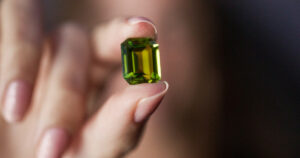
Peridot is a gemstone with a semi-translucent appearance formed deep on earth. Peridot is an uncommon example that may range in color from yellowish-green to brownish-green. Peridot is associated with the Hawaiian goddess Pele because it is ascended to the surface through volcanoes. Volcanic basalt, as well as meteorites on rare occasions, contain Peridot. Arizona, Hawaii, New Mexico, and Nevada are currently the only places where Peridot is mined.
Peridots may be found in various locations across the globe, including Australia, South Africa, Egypt, and China. Peridot is also known as Chrysolite, a Greek word that means ‘goldstone,’ and Olivine, which is derived from the mineral group. It’s a magnesium and iron-based silicate mineral. The color of a particular Peridot will become lighter and more yellow if there are greater amounts of iron. Despite its apparent appearance, Peridot has a colorless streak and vitreous luster.
It is used in everything from jewelry to talismans and is highly popular amongst people who study metaphysical properties.
The Mohs hardness scale rates Peridot between 6.5 and 7, with a high melting point. Peridot has been used as jewelry and decorations since antiquity. Peridot’s vivid hue and sheen make it a unique gemstone. It is widely used among individuals who study the metaphysical arts, and it may be found in everything from earrings to talismans.
What are the Benefits of Peridot?
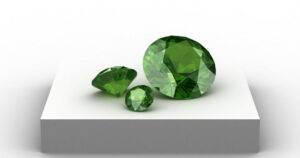
Peridot is considered to promote good health, peaceful sleep, and peace in relationships by regulating feelings and thoughts. The fantastic property of this amiable bright green stone to inspire eloquence and inventiveness and bring joy and good cheer is also uncanny.
What is Moldavite?
Moldavite (also known as ‘Vltavín’) is a popular, dark green colored semi-precious gemstone with a fascinating wrinkled texture in its natural condition. It belongs to the Tektite group. The exceptional qualities of healing all Chakras with its immense vibration energy have made this glassy, transparent gemstone famous.
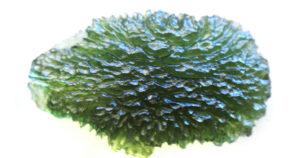
Moldavite is a silica glass with iron, magnesium, titanium, calcium, and potassium in small concentrations. This peculiar stone is thought to be about 15 million years old. When a meteorite with a diameter of around 1 kilometer impacted the earth, it caused damage in southern Germany. A new stone was formed due to the impact’s heat and pressure, as well as the meteorite’s minerals and composition.
Moldavite is believed to be an excellent energy healer. It is said to stabilize emotions, clear the mind and help promote focus. Moldavite is also known for its calming effects and ability to promote peace and harmony.
Moldavite is a deep green or blueish green stone semi-translucent in nature. Moldavite’s vitreous luster comes to life when polished or tumbled, and it can appear brighter. Moldavite has a white streak and is rated 5.5 to 7 on the Mohs hardness scale. Moldavite’s worm-like patterns are caused by winding deposits of lechatelierite, which can be seen all over the stone.
Moldavite pieces went airborne and may now be discovered in locations such as the Czech Republic, Bohemia, and Moravia. It was formed from the impact of a meteorite. Moldavite artifacts have been discovered in northern Austria.
However, Decorations and ornaments are the most common uses for Moldavite. The glass stone is a lovely stone for jewelry because of its deep, mossy green color. Moldavite is utilized in metaphysical healing practices, as it is with other one-of-a-kind gems.
Read this to learn more about How a Moldavite is formed
What are the Benefits of Moldavite?
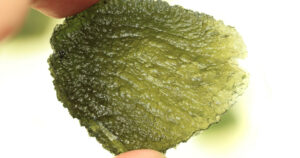
It is used for bringing high-quality changes within the wearer’s life to a physical, emotional, and spiritual degree.
How Peridot and Moldavite are Similar?
Peridot and Moldavite have a lot in common when it comes to color and composition. The stones have an opaque or vitreous luster akin to glass and are primarily composed of silica.
Iron and magnesium are also present in them. They have a similar hardness, which they share. Moldavite has a melting point of 1200C, while Peridot has a melting point of 1300C. The original chemical structure of Peridot and Moldavite’s parent minerals was altered by intense pressure and heat, resulting in the creation of new minerals.
Both stones are made up of a large portion of silica, which makes them both behave like hardened glass. They aren’t similar, but they’re both silica-based.
How can Peridot and Moldavite Differ?
Since it originates from volcanic basalt and silica within the earth’s mantle, Peridot can be found all over the globe.
On the other hand, Moldavite is only found in southern Germany and the nearby regions.
Because of the different ways that each gem was created, there is a smaller amount of Moldavite in a finite area.
Both stones are similar in color, but their hues can differ greatly based on their composition.
The vivid green color of Peridot is well known. It can also be yellowish-green in tint.
On the other hand, Moldavite can appear in dark green or olive green. The patterns within the stone are also different between Moldavite and Peridot, whereas there are no discernible internal patterns in Peridot. Peridot is a kind of igneous rock that results from the melting of minerals in the earth’s crust.
Peridot is essentially a pure combination of silica, iron, and magnesium. Moldavite, on the other hand, is a natural substance composed of pure glass. Meteor impacts generate tektites, as does air-blown debris from shattered rocks, vapors, and molten chemicals. Moldavite is an extraterrestrial gemstone because tektites do not form on earth.
Common Reasons for Confusing Peridot and Moldavite
Green glass may be found in a well-polished, high-quality Moldavite or Peridot specimen. Unfortunately, we get confused by both these crystals frequently. It’s difficult to tell the difference between Peridot and Moldavite in jewelry and small ornaments. The two are frequently carved into various forms, and their green glass décor can only distinguish the three. Therefore, it is crucial to develop scientific procedures for distinguishing Moldavite and Peridot.
The Moldavite will scratch easier and quicker than the Peridot.
Peridot has a Mohs hardness rating of 6.5, while Moldavite has a low-end Mohs hardness value of 5.5. Diamond has a hardness of 10, while quartz has a hardness of 7. You can tell which is which by testing clear quartz on a Peridot or Moldavite specimen. Compared to the Peridot, the Moldavite will scratch more easily and quickly.
What gemstone family is Moldavite?
Moldavite is a tiny family of natural glass rocks that belongs to the Tektite group of minerals. Moldavite is also known as “the gemstone created from the stars” or “the gemstone found on Earth.”
What gemstone family is Peridot?
Olivine mineral family: The Olivine mineral family, which is a magnesium iron silicate composition, has just one famous member: Peridot. Except for gem-grade specimens, Peridot and Olivine are practically identical minerals.
Conclusion
Due to their silica structure, both Peridot and Moldavite seem to be glass-like in appearance, even though they are two different gems. Peridot is a scarce Jem that may be found across the globe near volcanoes. It’s a semi-hard stone with an opaque, semi-translucent appearance that doesn’t scratch easily.
It might range from pure green to dark green, for example.
Moldavite, on the other hand, is a green stone formed via millions of years of a meteorite impact in Germany. It is light green to dark green.
These extraterrestrial gemstones are just another glittering chapter in the earth’s creation, solar system, and the eternal, remarkable interplay between masses orbiting in space.
